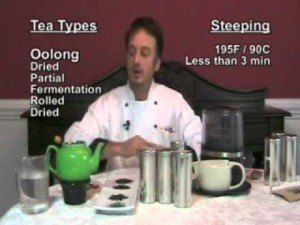Keep reading and get 15% off your first order of Teatulia
Now that I’ve ditched the paparazzi that have been following me all week, we can sit down together calmly and I’ll tell you all about tea, what makes them different, and how to correctly make a great cup.
There are countless types of tea available, but the four most common are White, Green, Oolong, and Black. These teas are all Camellia leaves that are treated or processed differently. The variations in processing give the teas distinctive flavors and alleged health benefits.
I’m not talking about herbal teas, they are not made with tea leaves, but an assortment of other herbs and aromatics to flavor hot water. They do not contain the same compounds found in Camellia leaves.
White tea is the least processed. Its leaves are steamed and dried. Thus, white tea is considered “young” tea and has a very delicate, light flavor.
Green tea is produced by letting leaves wither and dry in the sun, and are then steamed or dry-heat fried, and then rolled to crack the surface and left to dry again.
Oolong tea is first dried, then shaken or rolled to bruise the leaves and partially fermented. Fermentation takes place when oxygen acts on the tea leaves and causes chemical changes in the structure of the tea leaf. After the tea leaves are oxidized, they’re then dried or dry-heat fried to finish.
Black teas are the most processed. They’re rolled after initial drying, and then left for extended periods of time to fully oxidize, ferment and turn black. Often, they are “fired” or dry roasted even further to arrive at a full bodied black tea.
Here’s a quick chart to remind you:
White Tea ——————–Steamed ————————————————— Dried
Green Tea ——-Dried –Steamed –Rolled ————————————–Dried
Oolong Tea ——Dried ————————————-Partial Ferment ——–Dried
Black Tea ——–Dried ——————-Rolled ——Full Ferment ———–Fired
Correct brewing procedures are essential in steeping a great cup of tea. I feel that many people avoid white and green teas because they haven’t prepared them correctly.
The mistaken belief is that the longer you steep tea, the stronger the flavor. This is incorrect, especially with white, green, and oolong teas. Green teas that are steeped for more than 2 minutes begin to give bitter flavors and will taste “grassy”.
To make a more flavorful cup of green or white tea, add more tea. Don’t steep longer, it just brings out bitter flavor.
Here’s a quick chart I’ve developed for steeping times to make the perfect cup of tea.
Tea Type tsp/8oz Temp Steep Time
White Tea 1.5 175F/79C 5 min
Green Tea 1 175F/79C 2 min
Oolong Tea 1 195F/90C 3 min
Black Tea 1 200F/93C 4 min
You don’t need to learn all about tea to find the type you like best. Experiment with the amount of tea and the steeping times that please your palate most.
Get 15% off your first order at Teatulia by using the promo code “TEATULIA” at check-out.



Have loved tea for years, especially oolong, black and Earl Grey. I’d like to see you address not only marinating food in tea but also smoking food with tea. In fact, the current (Feb 2011) issue of one cooking magazine (I’ll withhold the name, in case that would violate any of your site’s policies) features tea-smoked ribs and calls for oolong for that.
That is a GREAT suggestion. I think I can incorporate your idea when I work on grilling, marinades and smoking in the Spring.
I love using green tea along with an herbal/fruit tea in place of water in oatmeal or white tea or green as water for rice. My “flavorful liquid”. See, I DO listen 😉 BTW here is a video on how to make the kombucha that I wrote about. http://www.thehealthyhomeeconomist.com/2010/03/video-thursday-how-to-make-kombucha/ .
Thank you, Jennifer for sharing the additional resources with everyone.
You’ve taught me something today. See, you never stop learning.